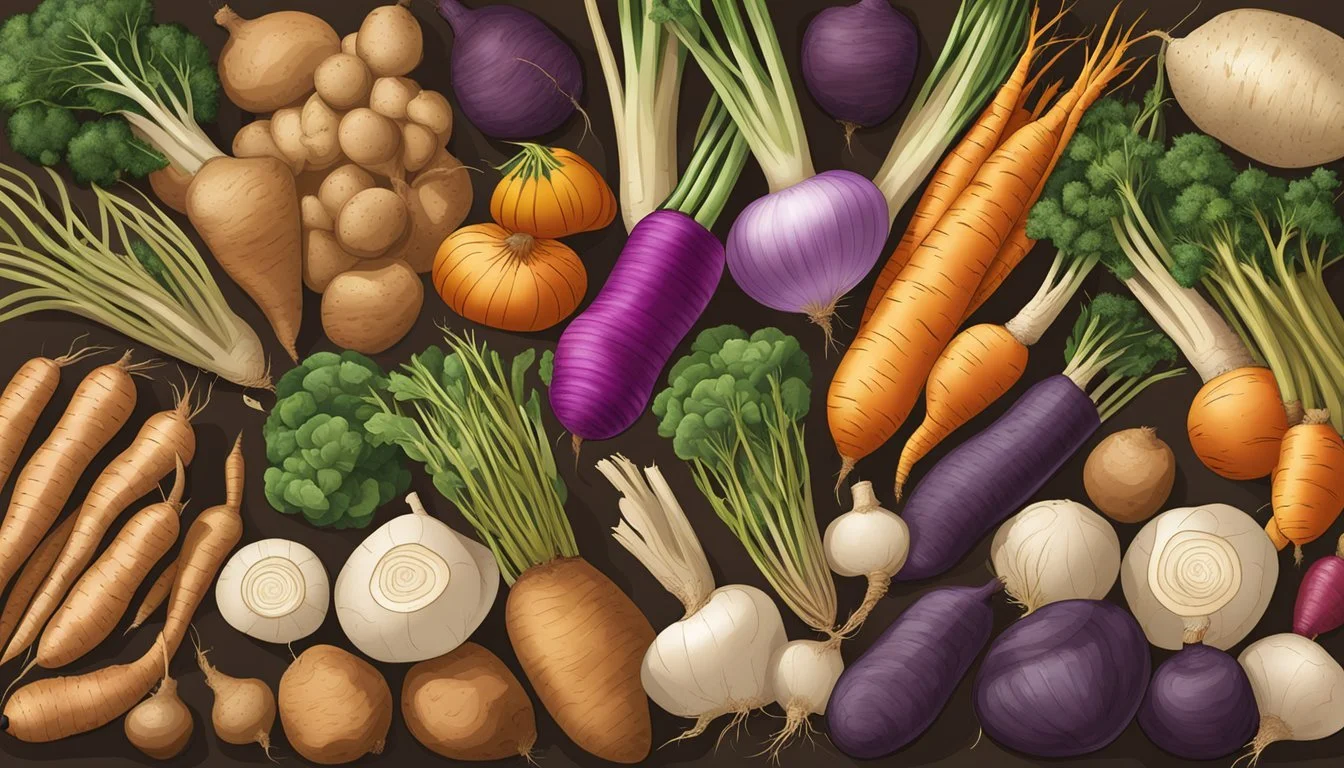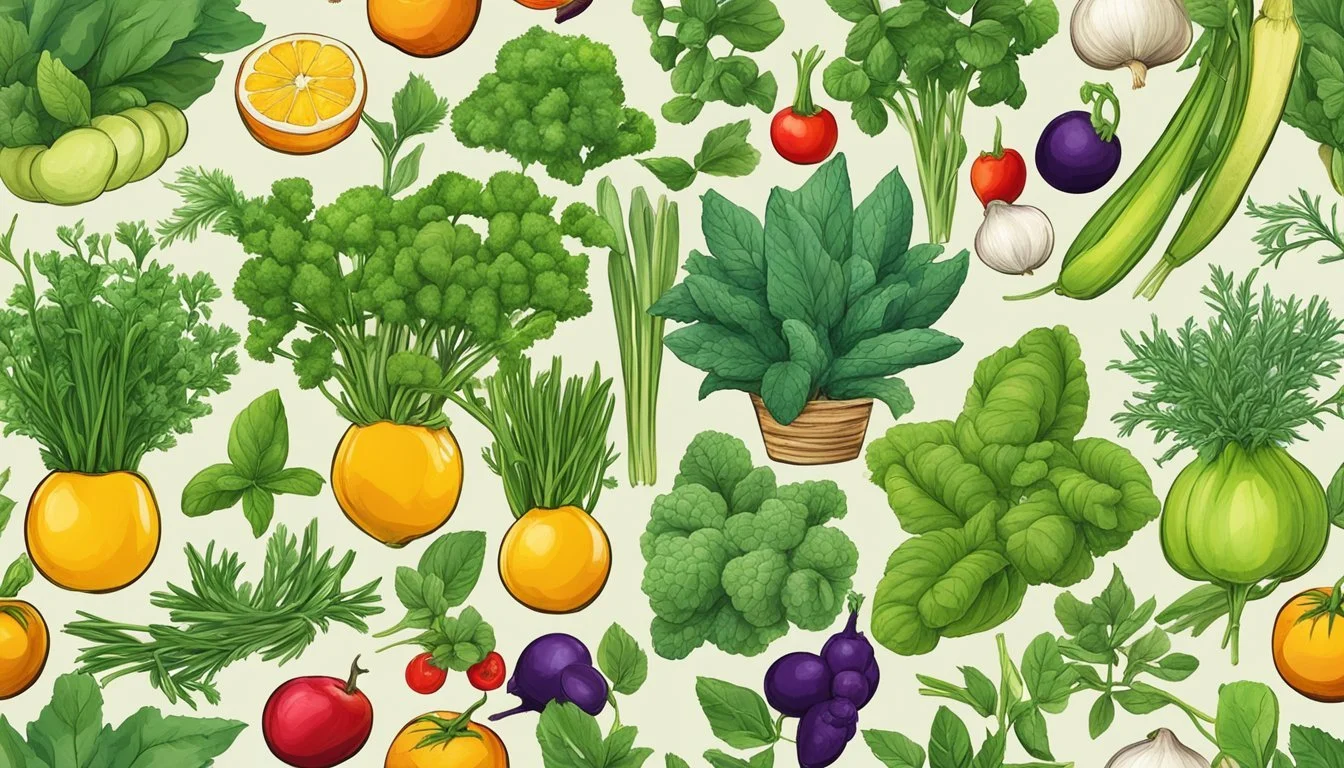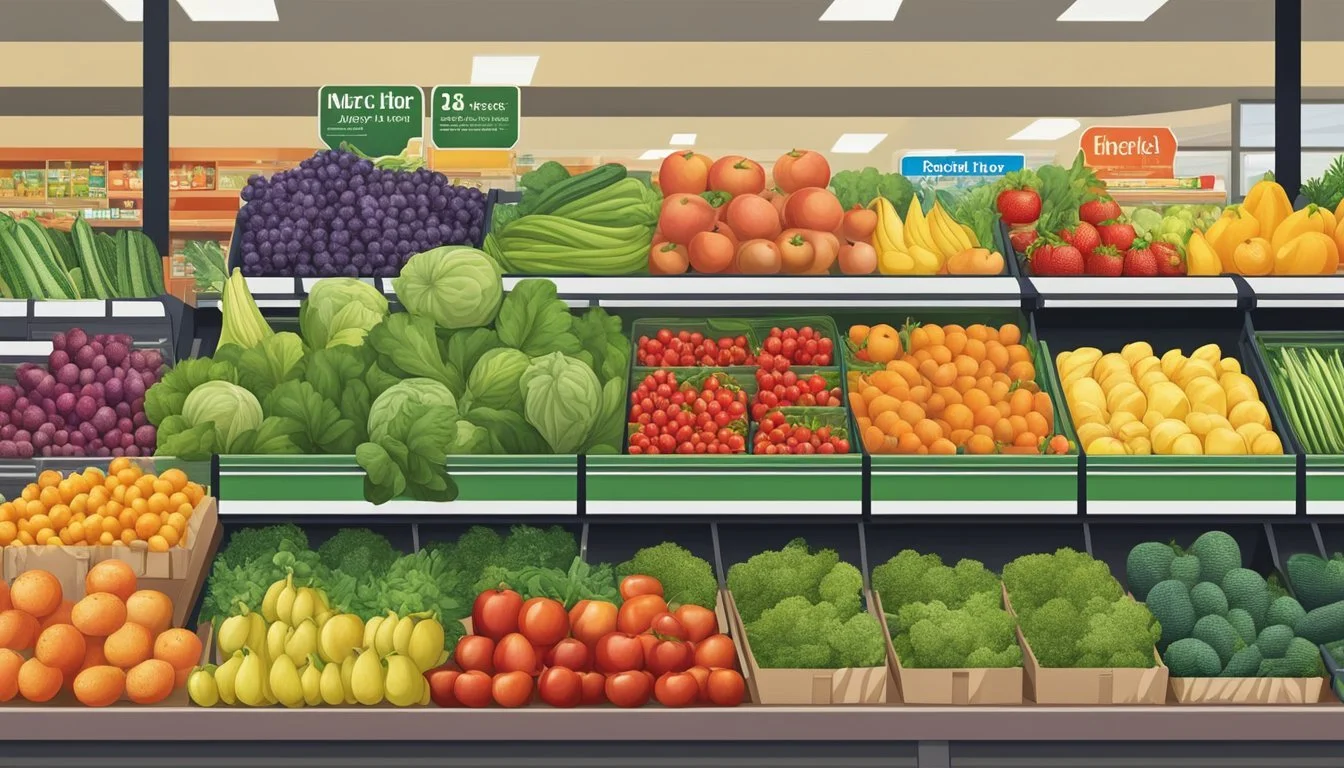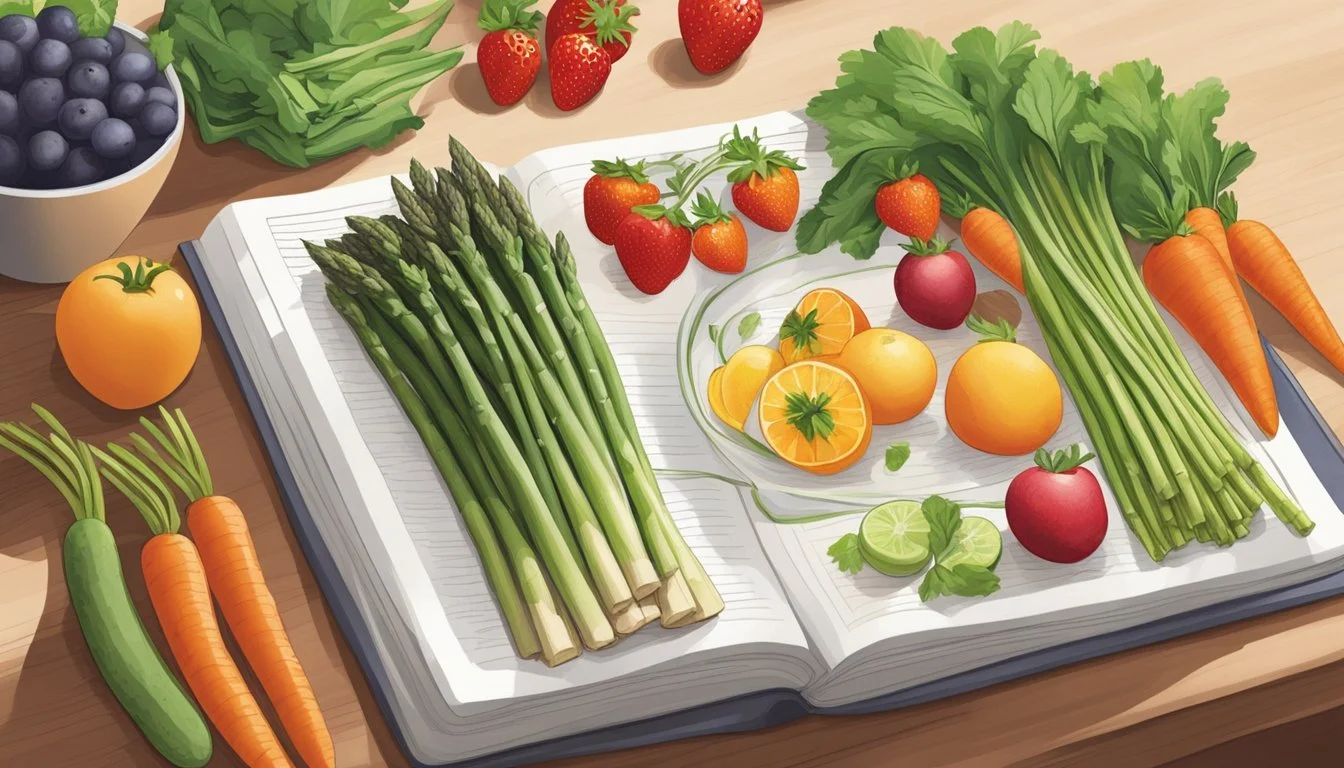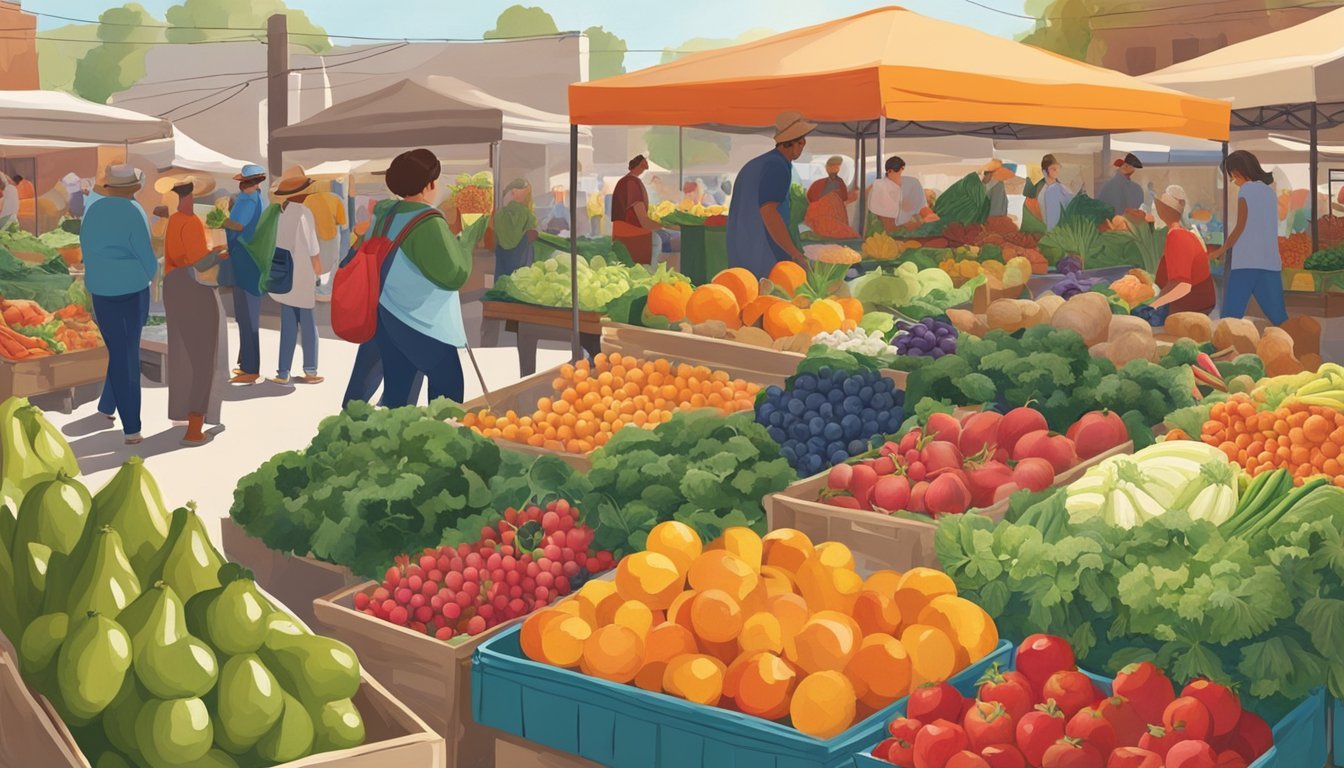Nevada Seasonal Fruit & Vegetables in March
Your Fresh Guide
This Article is Part of our Nevada Seasonal Fruit & Veg Calendar
In Nevada, the arrival of March signals a shift in agricultural focus, marking a time when farmers begin to harvest a variety of produce that has come into season. As the last vestiges of winter fade, the warmer temperatures and longer days provide ideal conditions for growing an array of fruits (What wine goes well with fruit?) and vegetables. This change of season allows for a diversification of the local fare available to Nevada residents and visitors alike.
Seasonal produce not only offers a fresh taste but is also indicative of sustainable and environmentally friendly eating habits. During March, farms across Nevada typically start to offer a diverse selection of crops. Asparagus (how long does asparagus last?), known for its tender shoots, emerges as a favorite of the season. Cruciferous vegetables like broccoli and cauliflower (how long does cauliflower last?) also reach peak ripeness, along with leafy greens including spinach and delicate lettuces. Root vegetables, such as radishes and turnips, continue to thrive in the cool yet temperate climate, providing a crisp and peppery addition to dishes.
Furthermore, the cultivation of seasonal fruits and vegetables in Nevada supports local agriculture and contributes to the regional economy. Locavores—those who prefer eating locally sourced food—find that March presents an opportunity to explore and enjoy the freshest produce that Nevada has to offer. By engaging with seasonal offerings, consumers can experience the state’s diverse agronomic capacity and the flavorful results of its unique growing conditions.
What's in Season? Overview of March in Nevada
In March, Nevada greets the spring season with a variety of fresh vegetables making their way to local farmers' markets. The state's climate across its regions determines what produce thrives, and during this month, gardeners and farmers harvest cool-weather crops that can withstand the still-chilly nights.
Vegetables:
Asparagus: Emerging as tender spears, asparagus is a highlight of the season.
Broccoli: Rich in nutrients, it provides a robust option for hearty meals.
Brussels Sprouts: These continue from winter, offering a burst of flavor.
Cauliflower: Versatile in dishes, its heads are picked at peak freshness.
Collard Greens (how long do collard greens last?): Known for their resilience, they remain a staple green.
Dill: This aromatic herb complements the season’s dishes with its feathery fronds.
Availability in March:
Leeks have a mild, onion-like taste and are ideal for enhancing soups and other dishes.
Lettuce varieties are in ample supply, perfect for salads.
Radishes add a peppery crunch to meals and are also readily available.
Nevada's distinctive growing conditions in March allow for these specific fruits and vegetables to flourish. While the focus is predominantly on vegetables, as the local fruit offerings are more scarce at this time of year, the selection of fresh produce in March is diverse enough to offer a balanced diet rich in seasonal flavor.
Consumers can take advantage of the growing cycle by incorporating these vegetables into their meal planning, ensuring they enjoy the freshest produce Nevada has to offer.
Key Fruits to Enjoy
March in Nevada brings about a transition as winter recedes and early spring fruits begin to appear. The cooler climate of the early spring means that most summer fruits are not yet in season, but there are still a number of delicious options for fruit enthusiasts to enjoy.
Citrus fruits remain a staple during this time, with varieties such as oranges and lemons offering a burst of fresh, tangy flavor that can be a refreshing contrast to the heavier flavors of winter produce.
In terms of apples, while the harvest season typically concludes in the late fall, some late-storage varieties are often available until spring. These apples may have a denser, slightly sweeter flavor as they have been stored and continue to ripen.
While pears also have a harvest season that typically ends in the fall, similar to apples, they are stored well and can be enjoyed into the spring months.
Given the storage practices and Nevada's climate, the following table shows the fruits that are typically enjoyed in March:
Fruit Type Description Notes Citrus Oranges, lemons Juicy, vibrant flavor Apples Stored varieties Dense, sweet flavor Pears Stored varieties Smooth, buttery texture
It's worthwhile to remember that these fruits do not represent a comprehensive list but are among the most notable ones that hold well through the season or are available due to modern storage techniques. Consumers can still find these fruits with reliability during March in Nevada, enjoying them in a variety of dishes or as fresh, standalone snacks.
Selection of Seasonal Vegetables in March
In Nevada, March heralds the arrival of spring and with it comes a variety of vegetables that are at their peak of freshness. At this time of year, shoppers and home cooks can delight in the vibrant flavors and nutritional benefits of seasonally available vegetables.
Asparagus emerges as a springtime favorite, known for its tender stalks and versatility in dishes. Asparagus can be steamed, grilled, or roasted and serves as an excellent side vegetable or a main dish when added to pasta or salads.
Broccoli and Cauliflower also make their seasonal debut, ready to be enjoyed for their crunchy texture and healthful properties. Both vegetables can be found in abundance and are ideal for a range of culinary uses, from raw snacks to hearty stews.
Leafy greens thrive in the cool yet mild Nevada climate of March. Kale and Spinach, with their dense nutrient profiles, are perfect for green smoothies, salads, and as cooked sides. The slightly warmer days of March encourage the growth of these greens, increasing their availability and quality.
Lettuce sees a spring resurgence as well, providing a fresh base for salads and sandwiches. Mixed lettuces are particularly tender and flavorful during this time.
Radishes offer a crisp, peppery bite to March's vegetable lineup. These root vegetables are often enjoyed raw, lending a delightful crunch and color to salads and are a sign that spring is well underway.
Availability Vegetable High Asparagus High Broccoli High Cauliflower High Kale High Spinach Moderate Lettuce Moderate Radishes
Cabbage is another staple appearing in March. Whether used in slaws, sautéed, or fermented into sauerkraut (how long does sauerkraut last?), cabbage is both versatile and abundant.
Consumers are encouraged to relish in these seasonal vegetables, as they are not only at the peak of their flavor but also often more affordable due to their abundance.
Spring Harvest: Embracing Green and Leafy Varieties
March in Nevada sees the awakening of the spring harvest, particularly focusing on green and leafy vegetables. As the ground thaws and the days grow longer, local gardens and farms start to flourish with vibrant greens.
Arugula (how long does arugula last?) becomes a highlight of many dishes during this season. This peppery leafy green thrives in the cool temperatures of early spring, making it a fresh addition to salads. It's best when harvested young, ensuring a more tender and less bitter flavor profile.
Chard, with its distinguishable bright stems and deep green leaves, also comes to the forefront. Full of nutrients and versatile in the kitchen, chard can be sautéed, added to soups, or eaten raw.
Salad enthusiasts can relish the crispness of these spring greens, as they add both flavor and visual appeal to their plates. With an array of textures and tastes, these leafy varieties can be combined to create robust and nutritious salads.
Here is a brief list of some key leafy greens and herbs to look out for in March:
Greens: Including a variety of lettuces which are just beginning their season.
Arugula: Perfect for salads, best when fresh and young.
Chard: Can be found in different colors, and eaten cooked or raw.
Gardeners and chefs alike eagerly anticipate the arrival of these greens, forming the backbone of the spring menu in Nevada. They represent the fresh potential of the season, and their versatility in the kitchen allows for exploration in flavors and preparations.
Root Vegetables and Tubers
March in Nevada sees a variety of root vegetables and tubers reaching their optimal time for harvest. These staple crops offer nutritional benefits and versatility in culinary uses.
Potato Varieties
Potatoes in Nevada come in several varieties, each with its distinct flavor and texture suitable for different cooking methods. Russet potatoes are common for their fluffy texture and are excellent for baking, mashing, or frying. Red potatoes and yellow potatoes tend to have a waxy texture, making them ideal for boiling and adding to stews or potato salads.
Russet Potatoes: Great for baking
Red Potatoes: Preferred for potato salads
Yellow Potatoes: Best for stews
Carrots and Beyond
Nevada's soil nurtures not only carrots (how long do carrots last?) but also a range of other nutritious tubers and root vegetables. Carrots are known for their crisp texture and sweetness, elevated when harvested at peak freshness in March. Other notable mentions include beets, parsnips, turnips, and radishes, each adding a different flavor profile and texture to dishes.
Carrots: Sweet and crispy, versatile in both raw and cooked forms
Beets: Earthy flavor, commonly roasted or boiled
Parsnips: Slightly sweet, often used in soups and stews
Turnips: Can be eaten raw or cooked, offering a peppery taste
Radishes: Crisp and peppery, excellent in salads
Though not as commonly associated with early spring, sweet potatoes may also be available, providing a sweeter and creamier option to the regular potato. It is to be noted, however, that their peak season often falls later in the year.
Herbs and Flavor Enhancers
March in Nevada marks the time for garden enthusiasts to start considering which herbs to introduce to their gardens. The region's climate at this time of the year is conducive to growing a variety of herbs that not only thrive but also provide robust flavors for a range of culinary applications.
Basil stands out as a popular choice, appreciated for its aromatic leaves which are often used in Italian cuisine. When planting basil, it should be noted that it thrives in warm, sunny spaces and requires regular watering to maintain its lush growth.
Basil Growing Tips:
Plant in a sunny spot
Water generously
Harvest leaves regularly to encourage growth
Garlic is another flavorful addition to the March herb garden. As a bulbous plant, garlic requires well-drained soil and ample sunlight, but once established, it is relatively low-maintenance. Garlic is highly regarded not just for its culinary uses but also for its health benefits.
Garlic Planting Advice:
Plant in well-drained soil
Ensure plenty of sunlight
Minimal care once established
In addition to their culinary uses, these plants provide sensory pleasure with their distinct scents and can enhance the garden's aesthetics with their foliage. When incorporating herbs into the garden, it is important to consider their specific care requirements for optimal growth and flavor development.
Planning for the Next Seasonal Shift
As March progresses, gardeners and farmers in Nevada should ready their operations for the transition from spring to summer crops. Proper planning ensures a seamless changeover and maximizes yield and quality.
Preparing for April Produce
In April, they typically focus on planting early spring vegetables and preparing for fruit tree blossoming. Key actions include:
Soil Preparation: They enrich their soil with compost and check pH levels to promote healthy plant growth.
Irrigation Checks: They inspect and repair irrigation systems in anticipation of drier months ahead.
Plant Selection: They choose cold-tolerant vegetable varieties that can withstand Nevada's variable spring temperatures.
Looking Towards Summer Harvest
As they approach June and July, the focus turns to heat-loving crops. They should:
Schedule Planting: They plant summer vegetables such as tomatoes, peppers, and squash, which thrive in Nevada's hot climate.
Pest Management: They implement pest control strategies to protect emerging summer crops from common pests.
Heat Protection: They use shade cloth or mulch to protect plants from intense sun and conserve water.
Through diligent preparation and attention to emerging weather patterns, growers ensure a bountiful summer harvest.
Nutritional Benefits of Seasonal Eating
Eating seasonal fruits and vegetables offers enhanced health advantages. These foods are often fresher and provide a higher content of vitamins and minerals. In March, the availability of certain seasonal produce in Nevada means that individuals can reap these nutritional benefits. Consuming produce at its peak freshness ensures that the fruits and vegetables haven’t lost significant water content, which can dilute their taste and nutrients.
Fruits and vegetables that are harvested during their appropriate seasons tend to contain more natural sugars, making them tastier and possibly more satisfying to consume in their raw state. This satisfaction with natural flavors could lead to a decreased need for added sugars or flavorings that are less beneficial to health.
Seasonal produce also often requires fewer preservatives or processes to maintain its freshness, as it typically travels shorter distances to reach consumers. This can influence the nutritional value of the produce, retaining more of its original nutritional content.
Here’s a quick look at the nutritional data of some common seasonal produce in Nevada:
Leafy Greens: High in fiber, vitamins A, C, and K
Asparagus: Rich in vitamin K, folate, and antioxidants
Spring Onions: Good source of vitamin C and dietary fiber
It's important to note that the nutritional data of produce can vary widely depending on the specific type, growing conditions, and post-harvest handling. Consumers interested in maximizing their health should focus on integrating a diverse range of seasonal, fresh fruits and vegetables into their diets. This contributes not only to individual health but can also support local farming communities.
Shopping and Storing Tips
When visiting markets or stores in Nevada during March, it's important to select fresh produce that is in season. Shoppers should look for vibrant, firm fruits and vegetables without any visible spoilage or wilting. Here is a brief guide for selecting and storing produce:
Selection:
Fruits: Choose fruits that are heavy for their size, indicating juiciness.
Vegetables: Opt for vegetables with bright color and crisp texture.
Storage Basics:
Refrigeration: Most fruits and vegetables will stay fresh longer when stored in a refrigerator. Utilize produce drawers to maintain humidity levels.
Room Temperature: Some produce, such as tomatoes, should be kept at room temperature to preserve their flavor and texture.
Preservation Tips:
Freezing: For longer preservation, freezing is an effective option. Wash, dry, and slice items before freezing.
Containers: Store produce in airtight containers or bags to reduce exposure to air and moisture.
Storing Specifics:
Produce Where to Store Tips for Storage Green Leafy Vegetables Refrigerator Use within a week, keep in perforated bags to maintain moisture Apples Refrigerator Store away from strong-smelling foods to prevent flavor absorption Root Vegetables Cool, dark place Ensure ventilation to inhibit sprouting
Shoppers should remember that proper storage extends the life of produce, reduces waste, and maintains nutritional value. Always adjust storage techniques based on the specific needs of each type of fruit or vegetable to optimize freshness.
Cooking and Recipes
March in Nevada offers a delightful array of seasonal produce that can be transformed into refreshing salads and heartwarming soups. These dishes celebrate the tail end of winter and the onset of spring, utilizing local ingredients that are at their peak of freshness.
Spring Salads
Salads in March are vibrant and full of texture. They often feature crisp greens such as arugula and young spinach, offering a peppery bite that pairs well with the sweetness of citrus fruits like oranges, which are still plentiful.
Example Spring Salad:
Base: Arugula or mixed baby greens
Accents: Sliced oranges, shaved carrots, and thinly sliced radishes
Dressing: A simple vinaigrette made with olive oil, fresh lemon juice, salt, and pepper
These ingredients can be tossed together for a salad that sings with the flavors of Nevada’s March produce.
Warm Soups for Cooler Days
Despite the approaching spring, there's still a chill in the air that makes warm soups comforting. Ingredients such as locally grown carrots and celeriac add depth to any broth-based or creamy soup.
Carrot and Celeriac Soup Recipe:
Ingredients: Diced carrots, celeriac, onions, vegetable stock, herbs (like thyme), salt, and pepper
Preparation: Sauté onions, add carrots and celeriac, pour in stock, simmer until vegetables are tender, then blend until smooth
Garnish: A sprig of fresh herbs or a dollop of cream adds a final touch
This soup showcases the earthiness of celeriac and the natural sweetness of carrots harvested in Nevada.
Farmers Markets and Local Produce
In the state of Nevada, March offers an opportunity for individuals to explore local farmers markets in various cities, providing access to fresh, seasonal produce. These markets serve as a hub for the community, connecting consumers with local farmers and the bounty of the region.
Local produce available in March includes but is not limited to:
Asparagus
Carrots
Spinach
Visitors to Nevada's farmers markets can expect to find an assortment of these vegetables, which are known for their freshness and quality. The markets are not just a place to buy food; they represent the city's commitment to supporting local agriculture and fostering a sense of community.
City Market Name Notable Produce Las Vegas Downtown Summerlin Market Artichokes, Asparagus Reno Riverside Farmers Market Carrots, Spinach
The markets typically offer a variety of other goods, including organic options, which appeal to health-conscious consumers looking for nutrient-rich foods. March is a transitional month in Nevada when the last of winter produce overlaps with the beginning of spring offerings.
These markets not only bring fresh, seasonal produce to the urban centers of Nevada but also offer an experience that encourages local engagement. Here, one can learn directly from growers about the best ways to enjoy the seasonal bounty and become more informed about sustainable practices within the state.
Farmers markets in Nevada thus reflect both the season's offerings and the thriving local agricultural community, presenting consumers with a transparent pathway to high-quality, seasonal food.
Sustainability and Supporting Local Farmers
In Nevada, supporting local farmers during March, the cusp of the growing season, ties directly to sustainability. Local produce is not only fresher but also more eco-friendly due to reduced transportation distances, which correlates to a lower carbon footprint. Additionally, purchasing from local farmers supports the state’s agricultural economy and preserves the rural agricultural landscape.
Farmers Markets and Community-Supported Agriculture (CSA) programs are one avenue by which residents can obtain seasonal produce such as spinach, radishes, and lettuce, which begin to appear in March. These markets provide a direct link between consumers and producers, ensuring food dollars stay within the community, benefitting the local economy.
Season Extension Techniques, like greenhouses, allow Nevada farmers to produce vegetables outside the conventional season, thus enhancing sustainability. This innovation leads to food security, as it diversifies local food sources and reduces dependence on out-of-state imports.
Education and Programs: The integration of educational efforts, such as those facilitated by Sierra Harvest, helps to inform consumers about the importance of local agriculture. Programs like Nevada’s Home Feeds Nevada Agriculture Food Purchase program exemplify how state support can amplify local food systems, stimulate local economies, and reinforce food sovereignty.
In summary, sustainably supporting local farmers in Nevada during the month of March and beyond yields multiple benefits. It fosters a resilient food system, reduces environmental impact, and fortifies community ties. The collaboration between consumers, farmers, and state agencies is integral to this local-sustainable model that champions Nevada’s agrarian roots and paves the way for a greener future.
Conclusion: The Richness of Nevada's March Bounty
March in Nevada offers a refreshing selection of seasonal produce that locals and visitors alike can enjoy. The state's varied climates contribute to the unique availability of both cool-season vegetables and certain hearty fruit varieties during this time of year.
Vegetables: Gardeners and farmers in Nevada make the most of the early spring period to grow an assortment of cool-season crops. For example, spinach and kale thrive in March's mild temperatures, presenting fresh and nutritious options for consumers.
Leafy Greens: Spinach, kale, and lettuces
Root Vegetables: Radishes and carrots
Alliums: Onions and garlic
Fruit: While March is not the peak time for a wide range of fruit in Nevada, one can find certain cold-hardy varieties that withstand the cooler nights and occasional frosts.
Apples: Varieties such as the Golden Delicious or Granny Smith may still be available from the previous fall harvest, stored in optimal conditions to maintain their crispness and flavor.
Herbs: As the ground begins to thaw, some perennial herbs start becoming available and can add fresh flavors to early spring dishes.
Herbs: Chives, parsley, and cilantro
Produce grown during this month is typically robust and can offer an abundance of taste and nutrition. By prioritizing local, seasonal offerings, consumers benefit from enhanced freshness and support sustainable agricultural practices within Nevada. With an appreciation for what the land yields in March, Nevada showcases a modest yet valuable assortment of fresh produce during this transitional season.





